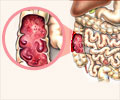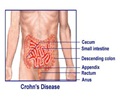While trying to improve cancer immune therapy, researchers unexpectedly produced the most accurate mouse model to date of inflammatory bowel disease (IBD).
While trying to improve cancer immune therapy, researchers unexpectedly produced the most accurate mouse model to date of inflammatory bowel disease (IBD).
IBD is a group of conditions that afflict approximately 1.4 million Americans with abdominal pain, constipation and diarrhoea. The two most common forms of IBD are Crohn's disease and ulcerative colitis (UC), which can be fatal in extreme cases.The mouse model, developed by Thaddeus S. Stappenbeck, M.D., Ph.D., assistant professor of pathology and immunology and of developmental biology and his colleagues, closely resembles the most serious form of human UC that is uniformly fatal.
However, the scientists were able to successfully treat the mice with a pair of broad-spectrum antibiotics, easing gut inflammation and increasing survival.
"The antibiotics we gave the mice were used individually in unsuccessful clinical trials as ulcerative colitis treatments, but now we have colleagues who are thinking of giving combined therapy an informal try. The antibiotics probably won't be a cure by themselves, but they may provide us with a potent new approach to combine with other therapies," said Stappenbeck.
With the help of these mice, the scientists can learn which species of gut microorganisms are getting involved in battles with host immune systems, initiating UC symptoms. This information could allow the development of stronger and more specific treatments.
The mouse model was created by crossbreeding two mouse lines developed for cancer immune therapy research. Each mouse line had one protein knocked out that restrained immune T cells from shifting into attack mode.
Advertisement
"I've looked at quite a few proposed mouse models of IBD, and I recognized right away that this had the potential to be outstanding. The colons of the mice were incredible. They were filled with inflammatory T cells. We found the mice almost exactly replicated the most acute types of ulcerative colitis ," said Stappenbeck.
Advertisement
According to the scientists, IBD is caused when host immune system damages the tissues of the gut while mistakenly attacking food and gut microorganisms that aid food digestion. However, it is difficult to sort out which species are being attacked by the immune system as there are an estimated 500 different species of microbes living in the gut.
The new model may considerably ease this difficulty. Even though the dual antibiotics used to treat the mice are broad-spectrum, they were unable to sterilize the guts of the mice, indicating that the treatment happened to eliminate the microorganisms causing IBD.
"We'd like to treat the mice and then reintroduce candidate microorganisms into their guts to see if this restarts the inflammatory reaction," said Stappenbeck.
The results of this study were reported in Public Library of Science-Medicine.
Source-ANI
SRM/L








